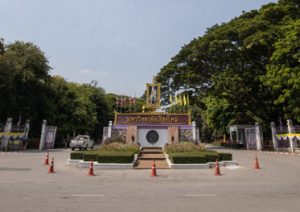
Chiang Mai University’s campus is famous for being one of the most charming campuses in Thailand. With its location on the foothills of Doi Suthep, its lush green grounds, its shady parks and pathways and its general user-friendly atmosphere, on any given day students may see the president or a vice president of the university walking around campus or inspecting the grounds, a normal friendly interaction between faculty and students which marks this unique campus.
Today CMU’s campus is making an even bigger name for itself for being the north of Thailand’s first Smart Campus, having implemented numerous technological and sustainable initiatives for the betterment of campus life.
Forty thousand people live on Chiang Mai University’s campuses which cover 2,000 rai of land. After implementing the CMU Smart City – Clean Energy, the project was selected as one in seven showcases by the Entity Conservation and Promotion Fund Office (ECPFO).
The thinking behind the Smart City concept is to harness the latest technology to facilitate better quality and higher sustainability of life for all residents. To that end, 2017-2021 has been slated, by the university, as the time period to implement many new changes concerning the university’s interaction with the environment and its consumption of energy.
Vice President of Chiang Mai University Associate Professor Prasert Rerkkriangkrai has been tasked with overseeing the environmental and energy strategy for the university, covering all innovative strategies for buildings, public facilities and the overall design of the Smart Campus.
“The CMU Smart Campus strategy was implemented following our understanding of our community’s many challenges. We then used technology and innovation to address those issues. It is not just about harvesting the usage of technology and innovation, but it is also about public participation,” explained Associate Professor Prasert. “The aim is for this to be a livable campus, a place which makes people happy and a place which is sustainable. Each place has its own set of problems with solutions which have to be adjusted accordingly.”
Smart Energy
“To save energy we simply have to cut down to three work days,” continued Associate Professor Prasert. “That is saving. But the problem with that is that our output will also reduce. If you are ill you go to the doctor who offers a diagnosis. We too have had to do that. We do an energy audit, like a doctor thoroughly checking every part of a patient’s body of ailments, we have done that to our buildings, our facilities, our spaces. Once we have the data, then we can manage it. Next we find other sources of energy such as solar energy or turning waste into energy. When you look up around canvas you will notice solar panels everywhere. Today Chiang Mai University’s campus has more solar cells than anywhere else in Thailand. We generate up to 40% of our energy from the sun. This is used for such things as hot water for our dorms and has helped reduce our electricity costs by 30%. Everything is managed by our Smart Grid system which allows for trade in energy. For ten years we talked about doing this, and I am pleased to say that today we have implemented it. If we have a surplus of energy on one building, we can now send it to the hospital to be used there. We have complete control of our energy map and can move it around whenever needed.”
Smart Environment
One point of great pride for the university is its bio-mass plant run by the Energy Research and Development Institute –Nakornping (ERDI-CMU) which is successfully turning the university’s waste into not just biodegradable waste, but also into energy. With a zero waste policy, the university is now processing 15 tonnes of waste per day in its plant, using multiple techniques to turn various waste into products and energy. The university’s Water Management system is also turning most of the waste water into the university into fresh usable water. Not only that, the bio-mass plant is being used as a teaching tool for students and faculty and will be for generations to come.
Smart Mobility
The central command for such initiatives is also smart. The Smart Campus Management Center controls all the data to streamline, and make most effective, the university’s many initiatives. A large screen features a bewildering number of real time safety, energy and environmental data — traffic flow, numbers of passengers on the free electric campus transport, CCTV cameras, PM2.5 levels, Wi-Fi hotspots, levels of garbage, usage of water, energy consumption, routes of patrol, etc. This information is then gathered and analysed, allowing for adjustments and fine tuning.
Chiang Mai University’s success story has led to the newest project in Chiang Mai – Smart Nimman. The university, along with various organisations, are overseeing the implementation of a Smart Nimman which will see a Smart Mobility system to streamline parking and traffic along the congested road and its lanes; the Smart Sensor will manage parking; Park and Ride will set up car parks with shared rides to nearby destinations; Shared Parking will also have an Online Booking system and Online Payment for convenience.
Smart Community
The Chiang Mai University Campus is blanketed with Wi-Fi, offering its students and faculty mobility and convenience. The popular Ang Kaew Reservoir has now been connected by a walkway to the Tad Chompoo Reservoir as well as many parks and green areas, extending the leisure and exercise routes for many. A 24 hour co-working space – Smart Classroom – allow students a safe space to learn and study at all hours, with multimedia and computer support.